Key takeaways:
- Swift’s clean and expressive syntax, alongside type safety, makes it accessible for beginners and reduces debugging efforts.
- The strong community support and integration with Apple’s frameworks enhance the development experience, fostering collaboration and innovation.
- A mix of structured learning resources and hands-on experimentation, including working on personal projects, is essential for mastering Swift.
- Future goals in Swift development include exploring SwiftUI, contributing to open-source projects, and integrating machine learning into applications.

Introduction to Swift programming
Swift programming represents a significant leap forward in developing applications for Apple’s ecosystem. I remember the thrill I felt when I first wrote a line of Swift code—it was like learning a new language that was both friendly and powerful. The syntax is clean and expressive, making it much more approachable for beginners, which is something I truly appreciate.
As I delved deeper into Swift, I found its type safety and performance really stood out. Have you ever struggled with frustrating bugs due to type mismatches? Swift helps mitigate that worry right from the start. By checking the types at compile-time, it provides a layer of security that allows me to focus more on building elegant features rather than constantly debugging.
Not only does Swift feel intuitive, but it also brings modern programming concepts like optionals and protocol-oriented programming to the table. I often think about how these features have enriched my coding experience and fostered a more robust mindset towards software design. Isn’t it exciting to work with a language that evolves alongside developer needs? The possibilities feel endless with Swift, and I can’t wait to see where it leads us in the ever-changing landscape of technology.
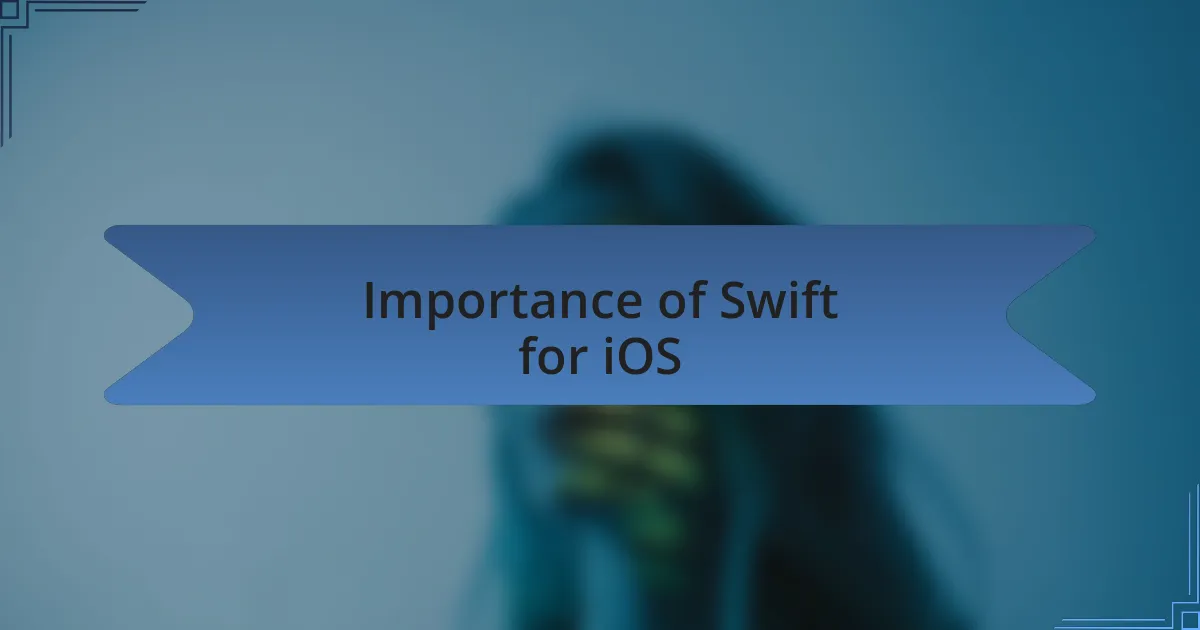
Importance of Swift for iOS
Swift has become the backbone of iOS development, and I can’t emphasize enough how crucial this is for anyone aspiring to create apps for Apple devices. I recall the first time I faced the choice between Swift and Objective-C—the clarity and modern approach of Swift drew me in like a moth to a flame. Its alignment with Apple’s ecosystem means that using Swift not only enhances performance but also keeps developers in sync with industry trends. Who wouldn’t want to stay relevant in such a fast-paced field?
One of the standout aspects of Swift is its community support. When I was tackling a particularly challenging feature, I found the resources and forums brimming with insights from other developers who had faced similar hurdles. This sense of camaraderie keeps me motivated and sparks innovative ideas as I engage with others, learning from their experiences. It’s amazing how a shared language can create a collaborative environment that feels welcoming rather than intimidating.
Moreover, Swift’s integration with Apple’s frameworks is another reason I find it indispensable for iOS development. I often dive into new APIs, and I’ve noticed how Swift seamlessly interacts with frameworks like SwiftUI and Combine. It creates a smooth workflow that allows me to prototype ideas quickly—the thrill of seeing my concepts come to life in real-time never gets old. Doesn’t the thought of harnessing such powerful tools make you eager to jump into Swift yourself?
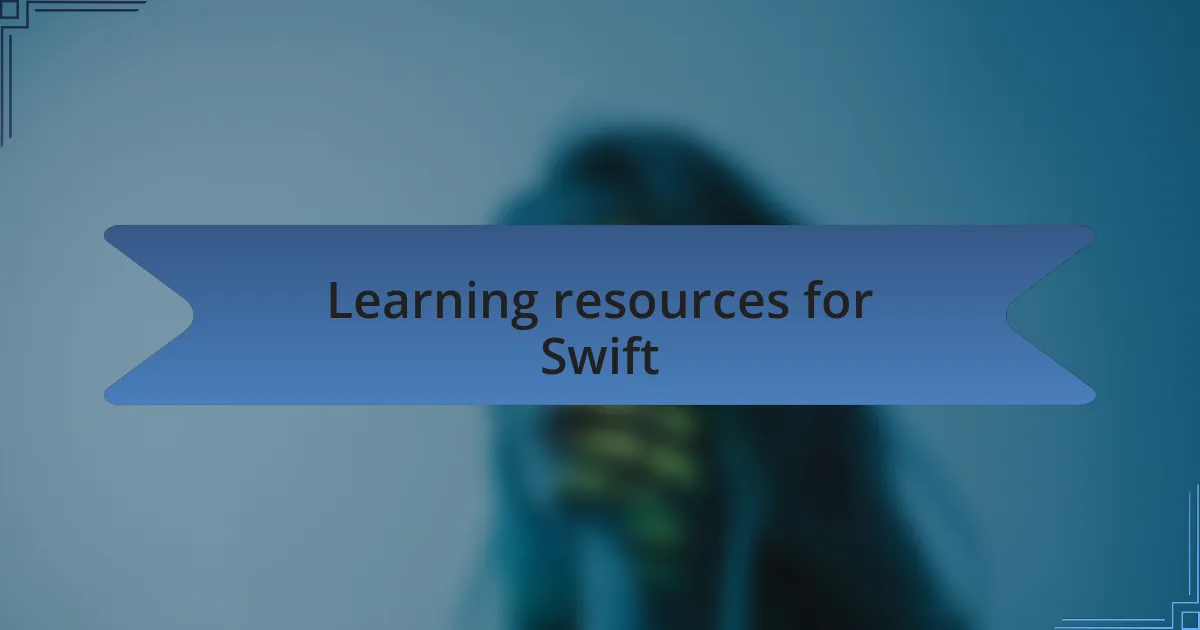
Learning resources for Swift
When it comes to learning Swift, I’ve found that a mix of online courses and books can be incredibly beneficial. Websites like Udemy and Coursera offer structured programs that guide you through everything from basic syntax to advanced concepts. I remember taking a course that featured hands-on projects; it made each lesson stick with me much better than traditional learning methods alone. Have you ever discovered that applying what you learn in real-time actually boosts your understanding? I certainly have.
In addition to formal courses, I can’t recommend Apple’s own documentation enough. It can be overwhelming at first, but once you find your footing, there’s a treasure trove of information waiting to be explored. I recall diving into the Swift Playgrounds, where I could experiment freely without the fear of breaking anything. That hands-on exploration allowed me to embrace my mistakes, and honestly, that’s where the real learning happens. Have you ever considered documenting your learning journey in a playground? It can be a fun way to track progress.
Don’t underestimate the power of community resources, either. Platforms like Stack Overflow and Swift forums are not just places to find solutions; they’re vibrant hubs of discussion where ideas flourish. I’ve posted questions that led to insightful conversations, and I always walk away feeling inspired and connected. Have you ever been surprised by how willing other developers are to help? It’s this very support that makes the journey of learning Swift not just educational but also enriching.
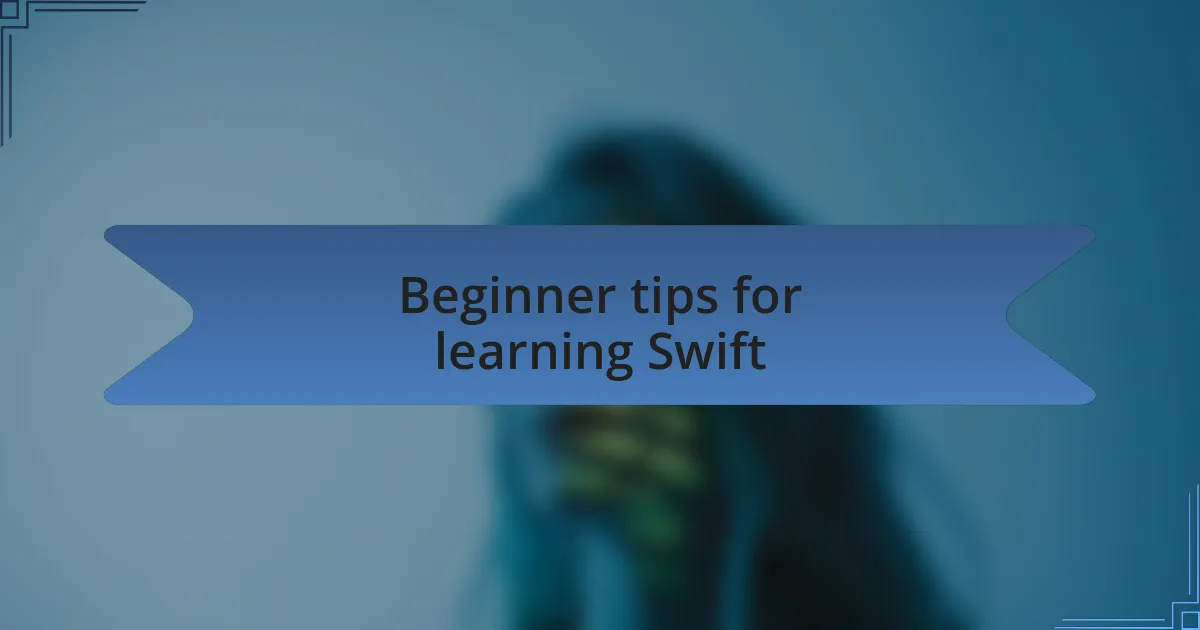
Beginner tips for learning Swift
It’s easy to feel overwhelmed when starting with Swift, but breaking it down into manageable chunks can make a world of difference. Early on, I focused on mastering the basics—data types, control flow, and simple functions—before moving on to more complex topics. Have you ever noticed how building a solid foundation helps everything else click into place? I find that clarity comes quicker when I take the time to nail down the fundamentals.
Another tip I can share from my experience is to embrace the project-based learning approach. I recall the thrill of creating a simple app that tracked my daily habits; it gave purpose to my coding exercises. Whenever you can apply what you’ve learned in a meaningful way, it transforms abstract concepts into tangible skills. Have you tried thinking of a small project that excites you? It can be a great motivator to push through the tougher learning moments.
Finally, don’t hesitate to experiment and play around with your code. Early in my journey, I used to be too cautious, but I learned that making mistakes is a vital part of the process. I remember breaking my code repeatedly while exploring new APIs but also discovering new ways to implement features through that trial and error. Asking yourself if you’re seeking perfection or progress can change how you approach your coding practice. What do you think—are you ready to let creativity lead your coding journey?
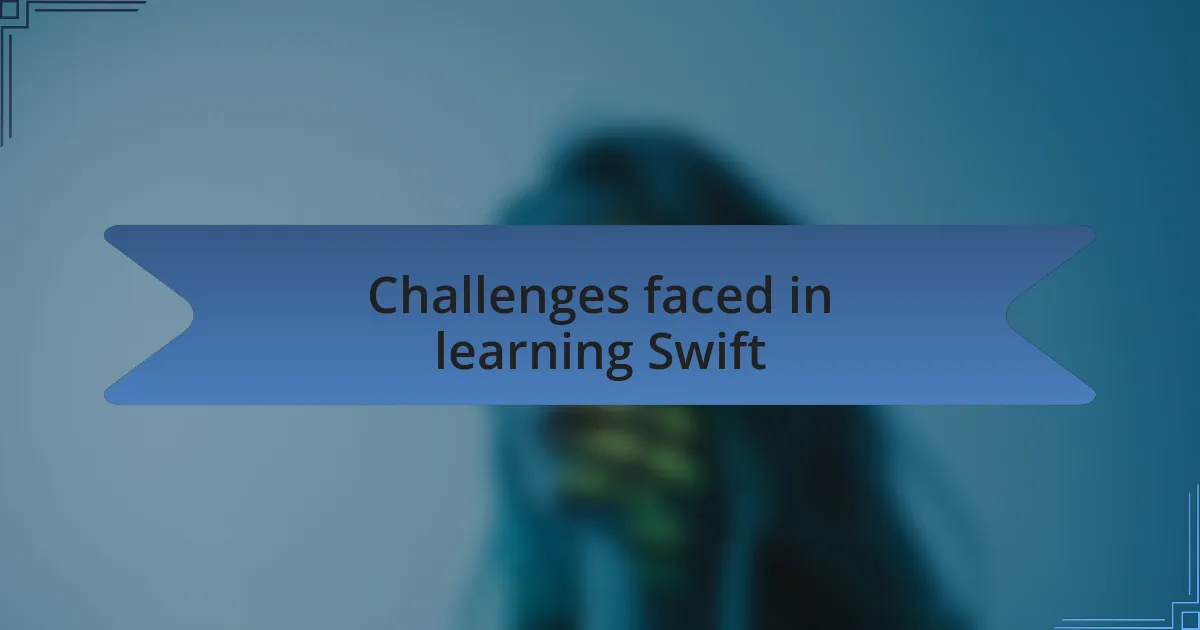
Challenges faced in learning Swift
One challenge I encountered while learning Swift was tackling its syntax and structure. At first, the use of optionals—variables that can hold a value or be nil—was perplexing. I remember staring at my code, constantly asking myself if I was using them correctly. It felt like everything was just a step away from working, yet those little details made all the difference. Have you ever found yourself stuck on a concept that seemed simple in theory but tricky in practice?
Another hurdle I faced was understanding Swift’s concepts of protocols and extensions. The learning curve was steep; I spent hours trying to grasp how they could enhance my code. I felt frustrated, as I was eager to create more dynamic apps. Reflecting on it, I realized that diving deeper into these features ultimately enriched my coding toolbox. Are there moments in your learning journey where you’ve had those lightbulb moments that changed your perspective?
Lastly, keeping up with Swift’s rapid evolution has been a real test of adaptability. Just when I felt I was catching up, a new version rolled out with changes and additional features. I remember feeling a mix of excitement and anxiety; how could I stay current with everything? Embracing this constant evolution has transformed my approach; now, I view it as a chance to learn continuously rather than a challenge to overcome. Does the idea of learning in an ever-changing environment inspire or overwhelm you?
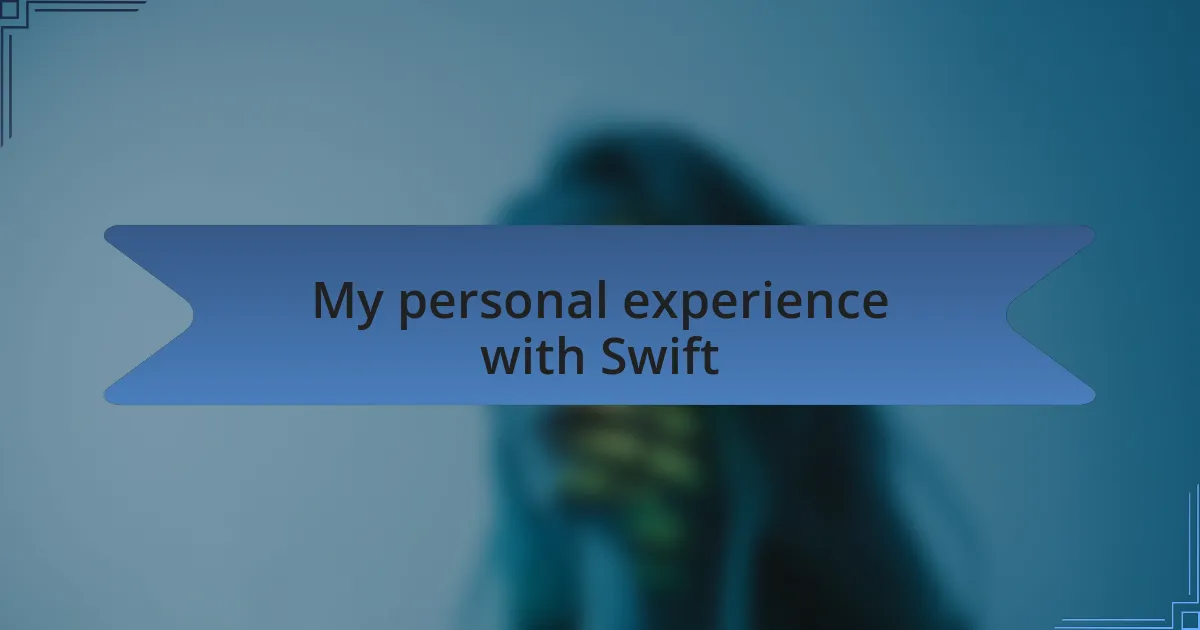
My personal experience with Swift
When I first started learning Swift, I was genuinely excited. I vividly recall my first project—a simple to-do list app. It wasn’t easy, especially debugging issues that seemed to come out of nowhere. There were nights I spent hours just trying to figure out why a function wasn’t returning the expected result. Have you ever felt that mix of frustration and determination?
As I delved deeper into Swift, I found immense joy in using closures. Initially, they seemed like an esoteric concept, but once I grasped their potential, I realized how they could streamline my code. I still remember the moment it clicked for me; I felt like I had been given a new tool that opened up a world of possibilities. Have you had that exhilarating feeling when a tough concept finally makes sense?
I also faced moments of self-doubt, particularly when comparing my progress to others in the community. I remember scrolling through forum discussions and feeling overwhelmed by more experienced developers. But those experiences taught me to appreciate my unique journey. Learning Swift has been about growth and resilience, not just about the code. Have you found yourself measuring your growth against others, only to realize your path is your own?
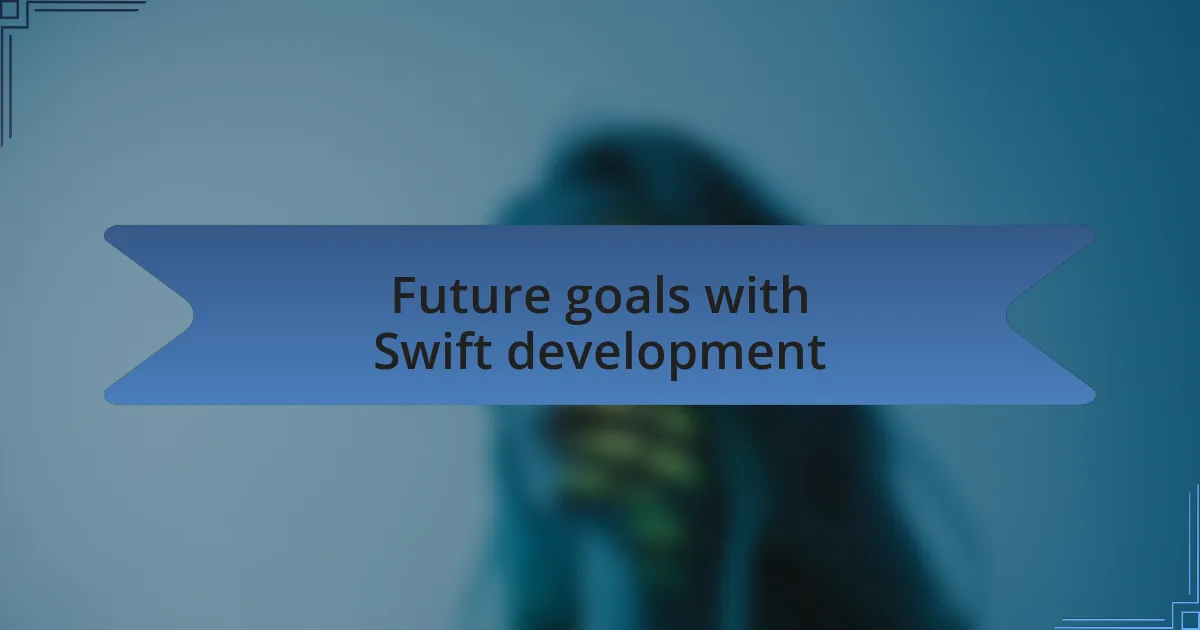
Future goals with Swift development
As I think about my future goals with Swift development, I feel a powerful sense of direction. I want to dive deeper into SwiftUI, Apple’s powerful framework for building user interfaces. The ability to craft visually stunning apps with less code is fascinating, and I’m eager to explore its potential more fully. Have you ever found a tool that seems to elevate your creativity? For me, that’s what SwiftUI represents.
Looking further ahead, I aim to contribute to open-source projects within the Swift community. Just the thought of collaborating with other developers, sharing insights, and learning from others is exhilarating. I craved that sense of connection during my journey. Have you ever thought about giving back to the community that has helped you? The idea of supporting others while enhancing my skills is something I find deeply motivating.
Ultimately, I envision developing more complex applications that integrate machine learning with Swift. I’m particularly drawn to the way Swift can handle performance-intensive tasks, which excites me about the possibilities. Tackling challenges like optimizing algorithms and data management makes my heart race with anticipation. Can you relate to that drive to push your skills further? It’s that hunger for growth that fuels my passion for the future of Swift development.